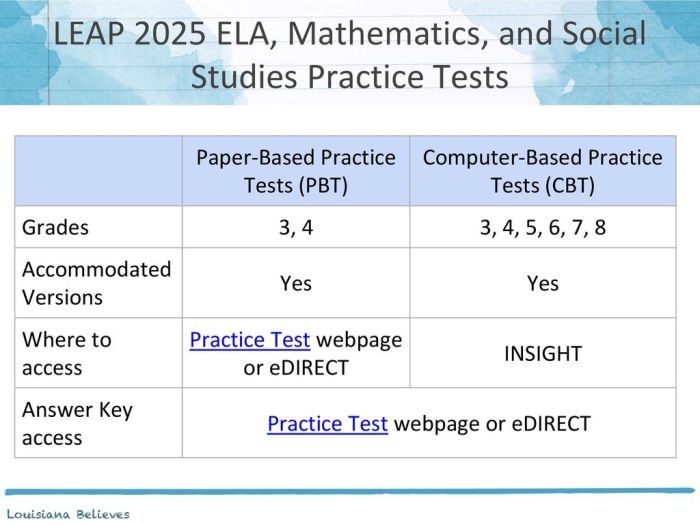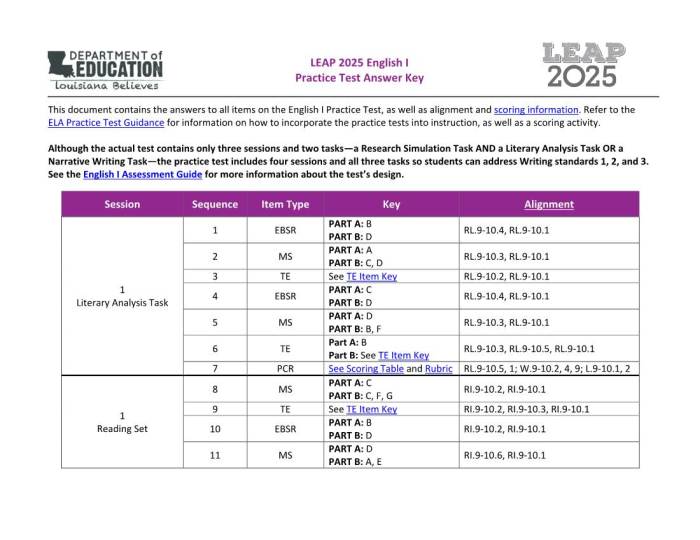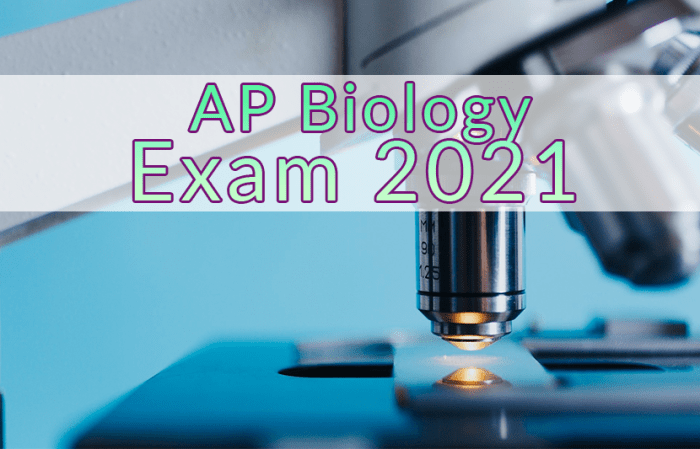Unveiling the Biology Leap 2025 Answer Key, a comprehensive guide to unlocking the future of biology. Dive into this insightful exploration of the initiative’s pillars, progress, impact, and more.
Biology Leap 2025, a groundbreaking initiative, aims to revolutionize the field of biology by fostering collaboration, innovation, and scientific advancements. This comprehensive guide provides a roadmap to understanding the initiative’s key elements and their implications for researchers, educators, and society as a whole.
Biology Leap 2025 Overview
Biology Leap 2025 is a global initiative launched in 2020 with the ambitious goal of transforming biology research and education by 2025. This initiative emerged from the recognition that the life sciences are undergoing a period of rapid advancement, driven by technological breakthroughs and the convergence of disciplines.
Biology Leap 2025 aims to harness these advancements to address global challenges and improve human health, well-being, and sustainability.
Key Stakeholders
The Biology Leap 2025 initiative involves a wide range of stakeholders, including researchers, educators, policymakers, industry leaders, and the public. The initiative is guided by a steering committee composed of experts from diverse fields, including biology, education, technology, and policy.
The committee is responsible for setting the vision and priorities of the initiative, as well as overseeing its implementation.
Key Pillars of Biology Leap 2025

Biology Leap 2025 is built upon a solid foundation of key pillars that guide its objectives and strategies. These pillars represent the core areas of focus that drive the initiative towards its ambitious goals.
The interconnected nature of these pillars ensures a comprehensive and synergistic approach to advancing the field of biology. Each pillar contributes to the overall success of the initiative, leveraging the strengths and expertise of diverse stakeholders.
Pillar 1: Foundational Research
Foundational research serves as the bedrock of Biology Leap 2025. This pillar focuses on supporting fundamental research that pushes the boundaries of biological knowledge. It aims to unlock new insights into the basic principles of life, from the molecular to the ecosystem level.
- Objective:To foster groundbreaking research that expands our understanding of biological systems.
- Strategies:Investing in high-risk, high-reward research; establishing interdisciplinary collaborations; promoting open access to research data.
Pillar 2: Translational Research
Translational research bridges the gap between basic science and clinical applications. This pillar focuses on harnessing fundamental biological knowledge to develop new therapies, diagnostics, and technologies that improve human health and well-being.
- Objective:To accelerate the translation of scientific discoveries into practical applications.
- Strategies:Establishing partnerships between academia, industry, and healthcare providers; providing funding for clinical trials; promoting the commercialization of research成果.
Pillar 3: Education and Workforce Development
Education and workforce development are crucial for ensuring a future generation of biologists equipped with the skills and knowledge to drive innovation. This pillar focuses on enhancing STEM education at all levels, from K-12 to graduate school, and supporting the professional development of scientists.
- Objective:To cultivate a diverse and highly skilled biological workforce.
- Strategies:Developing innovative teaching methods; providing hands-on research experiences for students; offering mentorship and training programs for scientists.
Pillar 4: Infrastructure and Technology
Infrastructure and technology provide the backbone for biological research and innovation. This pillar focuses on developing cutting-edge technologies, such as advanced imaging, data analysis tools, and computational modeling, that enable scientists to make new discoveries and address complex biological challenges.
- Objective:To create a state-of-the-art infrastructure that supports groundbreaking research.
- Strategies:Investing in research facilities and equipment; developing open-source software tools; promoting collaboration and data sharing among researchers.
Pillar 5: Societal Engagement
Societal engagement is essential for fostering public understanding and support for biology. This pillar focuses on engaging with the public, policymakers, and stakeholders to promote dialogue, address ethical concerns, and ensure that the benefits of biological research are shared equitably.
Solving the Biology Leap 2025 answer key can be a challenging task, but it’s worth it to improve your understanding of biology. If you need a break from studying, try your hand at the throw a bone to crossword . It’s a fun and challenging way to test your vocabulary and learn new words.
Once you’re refreshed, come back to the Biology Leap 2025 answer key and you’ll be ready to conquer it.
- Objective:To create a society that is informed, engaged, and supportive of biology.
- Strategies:Developing science communication programs; organizing public forums; engaging with policymakers on science policy.
Interconnections Between Pillars
The key pillars of Biology Leap 2025 are deeply interconnected and mutually supportive. Foundational research provides the knowledge base for translational research, which in turn drives the development of new technologies and therapies. Education and workforce development ensure a skilled workforce that can utilize these technologies and advance the field.
Societal engagement fosters public support and ethical considerations, which guide the responsible use of biological knowledge and technologies.
Implementation and Progress

Biology Leap 2025 is implemented through a comprehensive plan that involves collaboration between researchers, educators, policymakers, and industry leaders. The plan includes specific goals, timelines, and strategies for achieving the desired outcomes.
Implementation Plan
- Research and Development:Investing in cutting-edge research to advance biological knowledge and develop new technologies.
- Education and Training:Enhancing biology education at all levels to prepare a skilled workforce for the future.
- Infrastructure and Resources:Establishing state-of-the-art facilities and providing access to essential resources for research and innovation.
- Collaboration and Partnerships:Fostering partnerships between academia, industry, and government to accelerate progress.
- Policy and Regulation:Developing policies that support innovation and ensure responsible use of biological technologies.
Progress Updates
Since its launch, Biology Leap 2025 has made significant progress towards its goals:
- Research Advancements:Groundbreaking discoveries in genomics, bioinformatics, and synthetic biology have expanded our understanding of life.
- Educational Innovations:New teaching methods and curricula have improved student engagement and comprehension of biological concepts.
- Infrastructure Investments:State-of-the-art research centers and laboratories have been established to support cutting-edge research.
- Industry Collaborations:Partnerships with industry leaders have accelerated the commercialization of biological technologies.
- Policy Initiatives:Policy frameworks have been developed to guide the responsible development and use of biological technologies.
Case Studies
Numerous successful implementations of Biology Leap 2025 initiatives have been reported:
- Personalized Medicine:The development of genetic testing and targeted therapies has revolutionized healthcare, enabling personalized treatment plans for patients.
- Biomaterials and Tissue Engineering:Advancements in biomaterials and tissue engineering have led to the development of artificial organs and tissues for regenerative medicine.
- Agricultural Innovations:Biotechnology has improved crop yields, reduced pesticide use, and increased food security.
Impact and Outcomes

Biology Leap 2025 has the potential to revolutionize the field of biology. By promoting interdisciplinary research, fostering data sharing, and developing new technologies, the initiative aims to accelerate scientific discoveries and drive innovation.
The expected outcomes of Biology Leap 2025 include:
- Enhanced understanding of biological systems and processes.
- Development of new diagnostic and therapeutic tools.
- Advancements in biotechnology and personalized medicine.
- Improved understanding of the role of biology in environmental sustainability and human health.
Implications for Researchers
Biology Leap 2025 will provide researchers with access to vast amounts of data, advanced technologies, and collaborative opportunities. This will enable them to conduct more ambitious and impactful research, leading to groundbreaking discoveries.
Implications for Educators
The initiative will also impact education by providing educators with new resources and training to incorporate the latest scientific advancements into their curricula. This will ensure that students are prepared for the challenges and opportunities of the 21st-century workforce.
Implications for Society
The advancements made through Biology Leap 2025 will have a profound impact on society. Improved healthcare, environmental sustainability, and personalized medicine will lead to better quality of life and well-being for all.
Challenges and Opportunities: Biology Leap 2025 Answer Key

Biology Leap 2025 has encountered various challenges and opportunities during its implementation. Understanding these factors is crucial for assessing its progress and ensuring its success.
Challenges
One significant challenge is the complexity of biological systems. Biology involves intricate interactions and dependencies, making it difficult to isolate and study individual components. Additionally, the vast amount of data generated by modern research tools can be overwhelming, requiring sophisticated computational and analytical techniques.
Barriers and Obstacles
- Funding constraints can hinder research progress and limit the availability of resources.
- Regulatory hurdles and ethical concerns can delay or restrict research, especially in areas involving human subjects or genetically modified organisms.
- Public perception and skepticism can influence funding decisions and impact the acceptance of new scientific findings.
Opportunities, Biology leap 2025 answer key
Despite these challenges, Biology Leap 2025 also presents numerous opportunities.
Collaboration and Innovation
- Interdisciplinary collaboration between biologists, engineers, computer scientists, and other fields can foster innovation and lead to breakthroughs.
- Advancements in technology, such as artificial intelligence and machine learning, can accelerate data analysis and provide new insights into biological processes.
- Global partnerships and knowledge sharing can facilitate the exchange of ideas and expertise, enhancing the collective understanding of biology.
Questions Often Asked
What is the purpose of Biology Leap 2025?
Biology Leap 2025 aims to accelerate scientific discoveries and advancements in biology by fostering collaboration and innovation among researchers, educators, and stakeholders.
What are the key pillars of Biology Leap 2025?
The initiative focuses on four key pillars: research, education, workforce development, and infrastructure.
How will Biology Leap 2025 impact the field of biology?
The initiative is expected to drive transformative advancements in areas such as precision medicine, biotechnology, and environmental sustainability.
